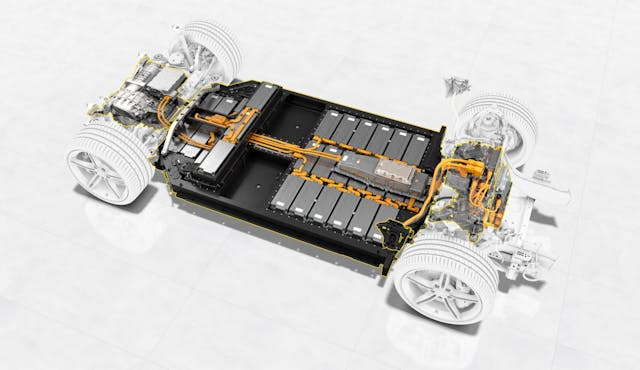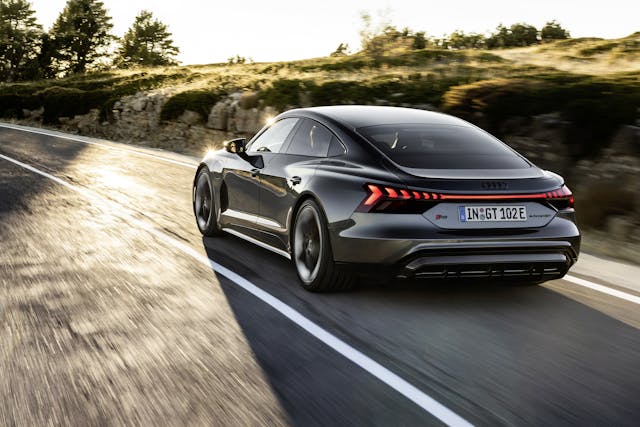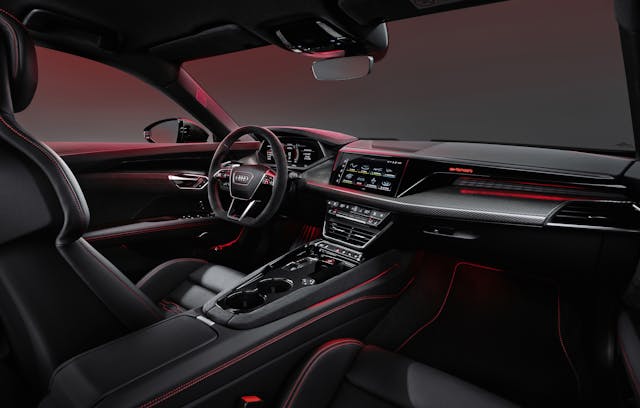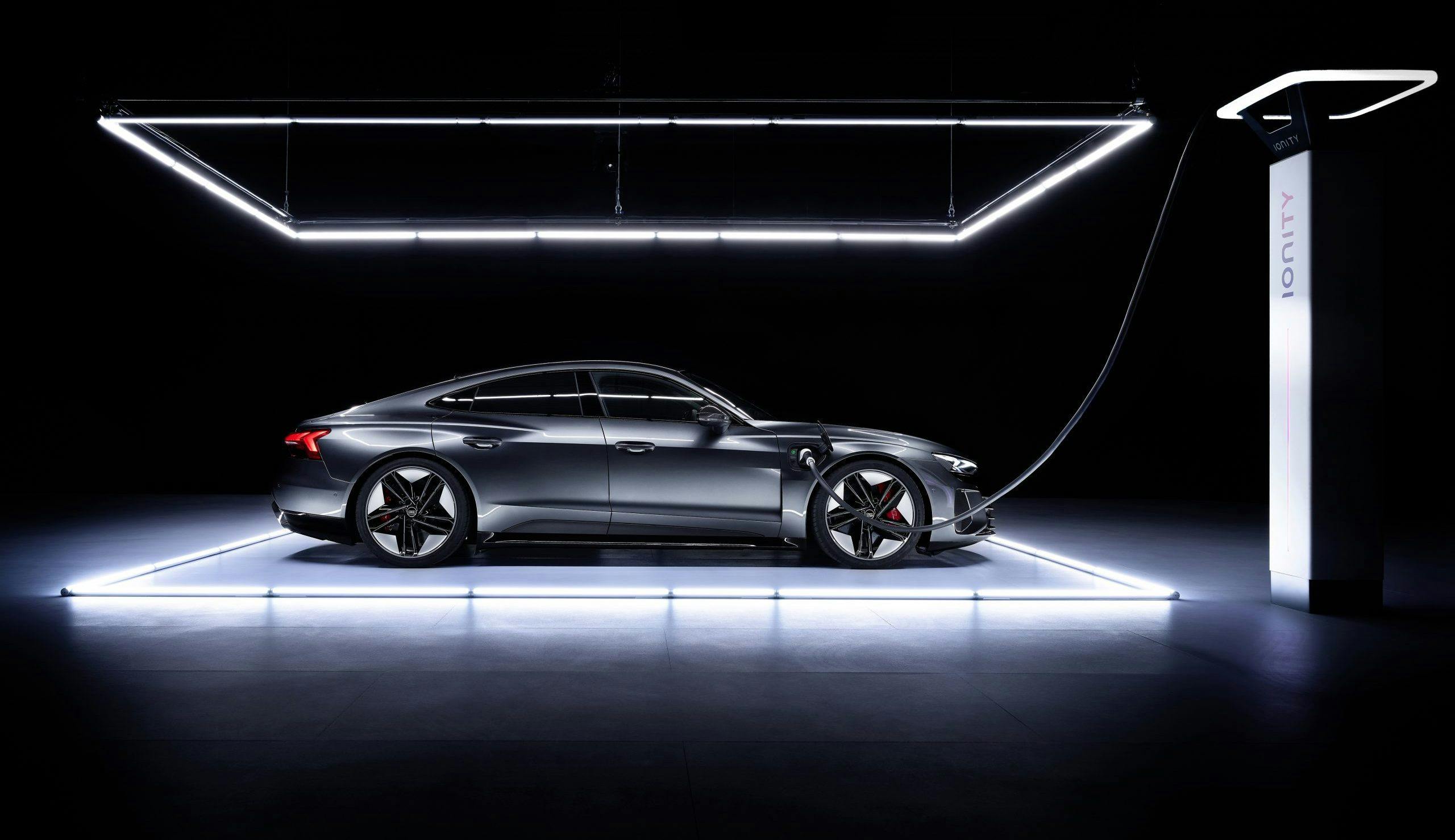The 2022 Audi e-tron GT puts a four-ring spin on the Porsche Taycan platform
For those who have some cash to splash and want to go all-electric, a new contender has entered the luxury EV segment: The 2022 Audi e-tron GT. Think of it like a four-ringed fraternal twin to Porsche’s Taycan.
Both EVs ride on the same all-wheel-drive, dual-motor, air-suspension platform, known in Porsche-speak as the J1. A 93.4-kWh lithium-ion battery pack and two permanently excited synchronous motors (PSM), one on each axle, form the backbone of the drivetrain and are paired with a two-speed transmission located on the rear axle. The entire system runs an 800-volt electrical architecture, allowing it to recharge from 5 to 80 percent in under 23 minutes on a 350 kW DC fast charger. Range, based on the European WLTP standard, is somewhere above 400 km (248.5 miles) on a full charge. Audi is only releasing approximate EPA test cycle numbers at the moment, but those are hovering around 235 miles.

The e-tron GT’s close relationship with the Taycan is an open secret. Given the shared platform and different brand missions within VW Group, Audi and Porsche met every three months during the J1’s development to ensure that the cars possessed sufficiently divergent personalities. The spec sheets for the two models presents one important differentiator: the e-tron GT will have four-wheel steering. Audi is also trumpeting a unique (and optional) feature for its swept-back EV sedan: a carbon-fiber-reinforced polymer roof, which saves 18 pounds but only negligibly improves the car’s performance.
When it comes to what’s visible from the outside, the only component shared between the e-tron GT and Taycan is the windshield. Even so, the two have a similarly attractive silhouette. The cutline of the front doors, which drops down the front fender nearly at right angles to the ground, also appears shared—likely a product of the identical design hard points dictated by the common platform.
When cooling demands are low, the e-tron GT’s radiator and brake duct inlets close to increase aerodynamic efficiency. The Audi’s drag coefficient is, at 0.24, .02 worse than the Porsche’s.
Like the Taycan, which includes a “Turbo” model in a vehicle without a turbocharger, the e-tron GT adopts a trim lineup familiar to Audi buyers. You’ll have a choice between three flavors of e-tron GT: two “regular” versions—the quattro Premium Plus and the quattro Prestige—and the top-of-the-line RS model. Both the standard e-tron GT and its RS variant use a 235-hp front motor, but the latter’s unit is complemented by a 450-hp rear motor; the regular car makes do with 429 hp on the rear axle. Combined system output for the standard e-tron GT is 469 hp and 464 lb-ft of torque.

In case you’re wondering how on earth one can get 469 by adding together 235 and 429, we asked Audi for more information. The issue is that usable power isn’t necessarily the same thing, in EV-land, as maximum output. The e-tron GT’s control units are in charge of monitoring the available power from the motors and evaluating how much of that the car can handle while preserving grip. All power and no way to use it all is a waste of energy, not to mention sub-optimal for performance. The Audi’s control units can put their heads together, however, and meter more than 469 hp in certain situations. With overboost—available for 2.5 seconds when launch control is activated—the regular e-tron GT’s horsepower figure jumps to 522.
Starting MSRP for this silent German chariot is $99,900 for the Premium Plus, or $107,100 for the Prestige, not including destination fees. Audi hasn’t graced our waiting ears with any other trim-level-specific details as of this writing.

If you’ve got an extra $40K, you can spring for the RS e-tron GT. It stickers at $139,900 and has a total combined output, between its two motors, of 590 hp in “normal” driving. On overboost, it makes 637 hp—more than any other Audi, including the 602-hp R8 V10 Plus. Total torque is 612 lb-ft, top speed is governed at 155 mph, and 0–60 takes a brief 3.1 seconds (3.2 seconds for the R8 V10 Plus). The standard e-tron GT takes 3.9 seconds.
Put in Porsche perspective, the e-tron GT is the equivalent of the 482-hp Taycan 4S model (with the Performance Battery Plus). At $100K and with 469 hp, the Audi is slightly cheaper and, if you ignore the overboost figures, marginally less powerful than the 4S. The RS e-tron GT falls between the Taycan 4S and Turbo in price, and in power, as well. The Tesla Model S has been putting up big performance numbers for years, and for $120K you can still pick up a 1020-hp Plaid, or, for $140K, a 1100-hp Plaid+ model.

As befits a model aimed at the deep-pocketed, tech-obsessed, and environmentally conscious, a leather-free interior festooned with the finest touchscreens in the Audi portfolio comes standard: a 12.3-inch one set behind the wheel and a 10.1-incher on the center console. Genuine dead-cow leather is optional, as it is in the vegan-as-standard Polestar 2.
EV-loving Audi diehards, your wait is over. The 2022 e-tron GT and RS e-tron GT hits U.S. shores this summer.




